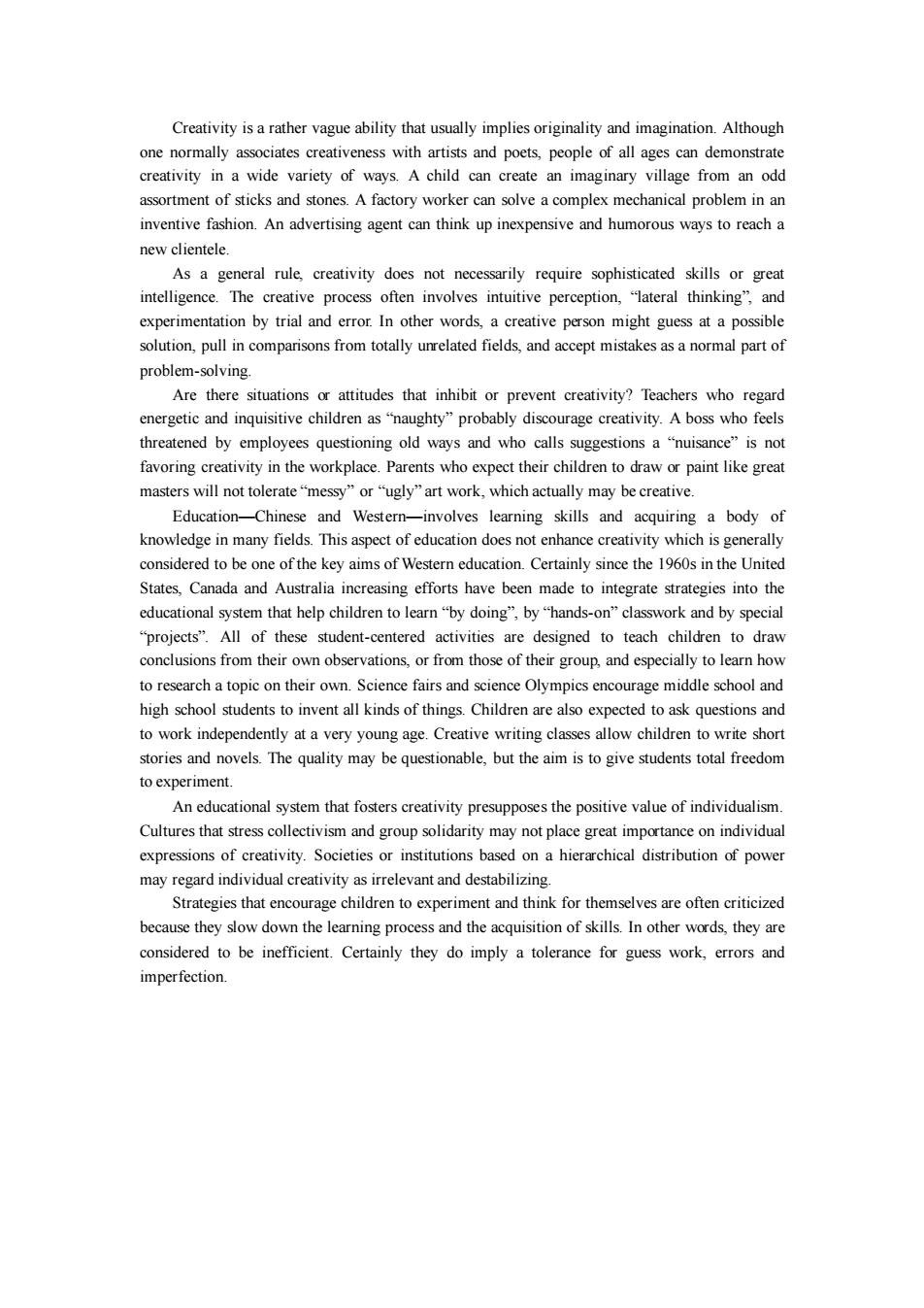
Creativity is a rather vague ability that usually implies originality and imagination.Although one normally associates creativeness with artists and poets,people of all ages can demonstrate creativity in a wide variety of ways.A child can create an imaginary village from an odd assortment of sticks and stones.A factory worker can solve a complex mechanical problem in an inventive fashion.An advertising agent can think up inexpensive and humorous ways to reach a new clientele. As a general rule,creativity does not necessarily require sophisticated skills or great intelligence.The creative process often involves intuitive perception,"lateral thinking",and experimentation by trial and error.In other words,a creative person might guess at a possible solution,pull in comparisons from totally unrelated fields,and accept mistakes as a normal part of problem-solving. Are there situations or attitudes that inhibit or prevent creativity?Teachers who regard energetic and inquisitive children as"naughty"probably discourage creativity.A boss who feels threatened by employees questioning old ways and who calls suggestions a "nuisance"is not favoring creativity in the workplace.Parents who expect their children to draw or paint like great masters will not tolerate“mesy”or“ugly”art work,which actually may be creative. Education-Chinese and Western-involves learning skills and acquiring a body of knowledge in many fields.This aspect of education does not enhance creativity which is generally considered to be one of the key aims of Western education.Certainly since the 1960s in the United States,Canada and Australia increasing efforts have been made to integrate strategies into the educational system that help children to learn"by doing",by"hands-on"classwork and by special "projects".All of these student-centered activities are designed to teach children to draw conclusions from their own observations,or from those of their group,and especially to learn how to research a topic on their own.Science fairs and science Olympics encourage middle school and high school students to invent all kinds of things.Children are also expected to ask questions and to work independently at a very young age.Creative writing classes allow children to write short stories and novels.The quality may be questionable,but the aim is to give students total freedom to experiment. An educational system that fosters creativity presupposes the positive value of individualism. Cultures that stress collectivism and group solidarity may not place great importance on individual expressions of creativity.Societies or institutions based on a hierarchical distribution of power may regard individual creativity as irrelevant and destabilizing. Strategies that encourage children to experiment and think for themselves are often criticized because they slow down the learning process and the acquisition of skills.In other words,they are considered to be inefficient.Certainly they do imply a tolerance for guess work,errors and imperfection
Creativity is a rather vague ability that usually implies originality and imagination. Although one normally associates creativeness with artists and poets, people of all ages can demonstrate creativity in a wide variety of ways. A child can create an imaginary village from an odd assortment of sticks and stones. A factory worker can solve a complex mechanical problem in an inventive fashion. An advertising agent can think up inexpensive and humorous ways to reach a new clientele. As a general rule, creativity does not necessarily require sophisticated skills or great intelligence. The creative process often involves intuitive perception, “lateral thinking”, and experimentation by trial and error. In other words, a creative person might guess at a possible solution, pull in comparisons from totally unrelated fields, and accept mistakes as a normal part of problem-solving. Are there situations or attitudes that inhibit or prevent creativity? Teachers who regard energetic and inquisitive children as “naughty” probably discourage creativity. A boss who feels threatened by employees questioning old ways and who calls suggestions a “nuisance” is not favoring creativity in the workplace. Parents who expect their children to draw or paint like great masters will not tolerate “messy” or “ugly” art work, which actually may be creative. Education—Chinese and Western—involves learning skills and acquiring a body of knowledge in many fields. This aspect of education does not enhance creativity which is generally considered to be one of the key aims of Western education. Certainly since the 1960s in the United States, Canada and Australia increasing efforts have been made to integrate strategies into the educational system that help children to learn “by doing”, by “hands-on” classwork and by special “projects”. All of these student-centered activities are designed to teach children to draw conclusions from their own observations, or from those of their group, and especially to learn how to research a topic on their own. Science fairs and science Olympics encourage middle school and high school students to invent all kinds of things. Children are also expected to ask questions and to work independently at a very young age. Creative writing classes allow children to write short stories and novels. The quality may be questionable, but the aim is to give students total freedom to experiment. An educational system that fosters creativity presupposes the positive value of individualism. Cultures that stress collectivism and group solidarity may not place great importance on individual expressions of creativity. Societies or institutions based on a hierarchical distribution of power may regard individual creativity as irrelevant and destabilizing. Strategies that encourage children to experiment and think for themselves are often criticized because they slow down the learning process and the acquisition of skills. In other words, they are considered to be inefficient. Certainly they do imply a tolerance for guess work, errors and imperfection